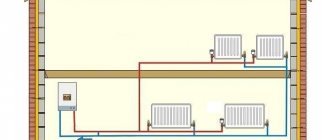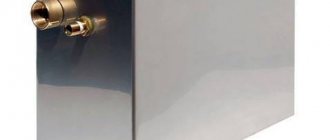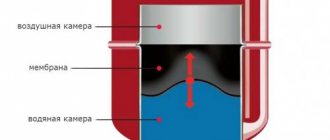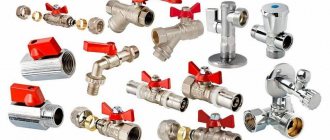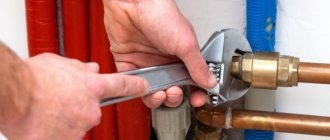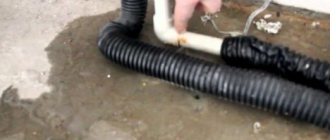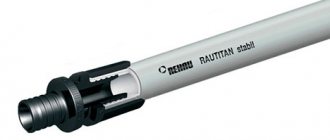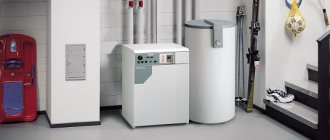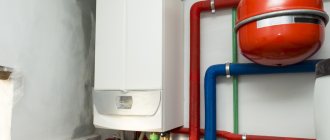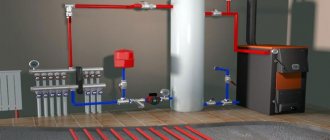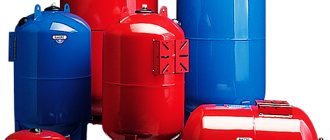An expansion membrane tank is an essential component of an individual water supply, without which the operation of the system is not possible. It is he who creates the necessary pressure for the full operation of the water supply system, makes reserve water reserves and even performs a number of protective functions. In connection with such a high importance of equipment, the question naturally arises: how to choose and correctly install a tank? To understand, let's approach the issue comprehensively: we bring to your attention the structure and principles of operation of the expansion device, its types, selection features, as well as a connection diagram and useful setup instructions with video.
Functions and operating principle
A membrane tank is a sealed, predominantly metal tank, consisting of two separated chambers: air and water.
The separator is a special rubber membrane - it is usually made of strong butyl, which is resistant to the development of bacterial microorganisms. The water chamber is equipped with a pipe through which water is directly supplied. The main task of the expansion membrane tank is to accumulate a certain volume of water and supply it at the user’s request under the required pressure. But the functions of the device are not limited to this - it also:
- protects the pump from premature deformation: thanks to the water reserve, the pump does not turn on every time the tap is opened, but only when the tank is empty;
- protects against changes in water pressure when using several taps in parallel;
- protects against water hammer that could potentially occur when the pumping unit is turned on.
Operation of the device
The principle of operation of the tank is as follows. When the pump turns on, water begins to be pumped into the water chamber under pressure, and the volume of the air chamber decreases at this time. When the pressure reaches the maximum allowable level, the pump turns off and the water supply stops. Then, as water is drawn from the tank, the pressure decreases and, when it decreases to the minimum allowable level, the pump turns on again and resumes pumping water.
Advice. During operation of the tank, air can accumulate in the water chamber, which causes a decrease in the efficiency of the equipment, so at least once every 3 months it is necessary to carry out maintenance of the compartment - to bleed excess air from it.
Design and functions of the expansion tank
The expansion tank is designed to maintain pressure in the water supply system. Most often, closed membrane-type equipment is used for water supply. It is a container with a rubber membrane installed inside. It divides the device into two chambers: air and water. After starting the system, the electric pump fills the system with water. The volume of the air chamber decreases. The smaller the volume of air in the tank, the higher the pressure.
A membrane type design is used as an expansion tank for the water supply system. A rubber diaphragm divides the device into two chambers: air and water
As soon as it exceeds the programmed level, the pump will be automatically turned off. It will turn on only after the pressure drops below the minimum programmed mark, and water begins to flow from the water chamber of the tank. The “off-on” cycle is repeated automatically. The pressure in the system can be checked using a pressure gauge, which can be installed on the equipment. The device can be customized by selecting your preferred operating pressure range.
A membrane expansion tank installed in a water supply system performs several functions at once:
- Maintains pressure when the pump is off.
- Protects the system from possible water hammer caused by voltage surges in the network or air entering the pipeline.
- Retains a certain amount of water under pressure.
- Protects pumping equipment from premature wear.
Using an expansion tank makes it possible, when water consumption is low, not to turn on the pump, but to cover water needs using the liquid stored in the tank.
Expansion tank as a battery
The tank is connected to the system to store additional water in case the water supply stops. The operating principle is as follows: the tank is connected by a branch pipe to the water supply pipes at any point, and when the tap is opened, water begins to fill the container. A check valve is installed on the connection to prevent water from flowing back.
As soon as the liquid gets inside, the membrane begins to move upward until the pressure of the compressed air above it equals the pressure of the water in the system. It is worth considering that the useful volume of the tank is approximately half of the total. When the water supply is turned off, liquid can be pumped out of the container through another valve.
Expansion tank for boiler
Water tends to expand when heated. When its temperature rises, its volume begins to increase. Since the heating system capacity is initially completely filled, excess liquid flows out.
To avoid water loss, an expansion tank is additionally installed above the boiler. He takes in the excess. The usable space inside the tank should be approximately 10% of the boiler volume.
Types of membrane tanks
There are two types of expansion membrane tanks:
- With a replaceable membrane - models that imply the ability to change the rubber membrane. At the first need, it can be removed through the flange by unscrewing its bolts. In large tanks, the membrane is additionally fixed to the nipple, which allows you to stabilize the device, but even in this case it can be easily removed from the mounts on the back.
Membrane for hydraulic accumulator - With a stationary membrane - tanks in which the separation membrane is fixed as rigidly as possible and cannot be replaced. If it fails, the entire device will have to be replaced. The price of such expansion tanks is lower than the cost of models of the previous type, but there is no need to talk about complete ease of use.
Advice. When choosing between a replaceable and stationary membrane, consider one important factor: in the first case, the water is completely contained in the membrane and does not come into contact with the inner surface of the tank, which eliminates corrosion processes, and in the second case, the contact is maintained, so it is impossible to achieve maximum protection against corrosion.
Features of choosing a tank
The main factor in choosing a membrane tank is its volume. When calculating the optimal tank volume, the following nuances should be taken into account:
- number of users of the water supply system;
- number of water intake points: taps, outlets for showers and Jacuzzis, outlets for household appliances and boilers that work with water;
- pump performance;
- the maximum number of pump on/off cycles in one hour.
To calculate the approximate volume of the tank, you can use the following guidelines from experts: if the number of users is no more than three, and the pump capacity is no more than 2 cubic meters per hour, then a tank with a volume of 20-24 liters is quite sufficient; if the number of users is from four to eight, and the pump performance ranges from 3-3.5 cubic meters per hour, a tank with a volume of 50-55 liters will be required.
When choosing a tank, remember: the more modest its volume, the more often you will have to turn on the pump and the higher the risk of pressure drops in the water supply system.
Advice. If you assume that over time there will be a need to increase the volume of the membrane tank, buy equipment with the ability to connect additional containers.
We select the volume of the tank.
Understanding the main functions it performs will help you choose an expansion tank.
The main task of the expansion tank (as it is also called from the English “expanse” - to expand) is to absorb the excess volume of coolant that is formed as a result of thermal expansion.
How much does the volume of water, as the main coolant, increase when heated?
When water is heated from 10 °C to 80 °C, its volume increases by approximately 4%. We must also not forget that a closed expansion tank consists of two parts, one of which receives an excess of expanding coolant, and the other is pumped with gas or air under pressure.
Taking into account the design of the expansion tank, it is recommended to select its volume as 10 - 12% of the volume of all water in the heating system of the house:
- in pipes;
- in heating devices;
- in the boiler heat exchanger;
- a small initial volume of water, which with an initial temperature under pressure enters the tank itself (static pressure in the system is usually higher than the air pressure in the expansion chamber).
Tank connection diagram
The membrane tank can be installed either vertically or horizontally, but in both cases the connection diagram will be identical:
- Determine the installation location. The device should be located on the suction side of the circulation pump and before the water supply branch. Make sure that there is free access to the tank for maintenance work.
- Secure the tank to the wall or floor using rubber pads and ground it.
- Connect a five-pin fitting to the tank nozzle using an American fitting.
- Connect in series to the four free terminals: a pressure switch, a pipe from the pump, a pressure gauge and a distribution pipe that supplies water directly to the intake points.
Connecting the tank
It is important that the cross-section of the connected water pipe is equal to or slightly larger in relation to the cross-section of the inlet pipe, but in no case should it be smaller. One more nuance: it is advisable not to place any technical devices between the expansion tank and the pump, so as not to provoke an increase in hydraulic resistance in the water supply system.
Why do you need an expansion tank for heating?
When the heating system operates, the coolant often changes its temperature - it either heats up or cools down. It is clear that the volume of liquid changes. It either increases or decreases. Excess coolant is forced out into the expansion tank. So the purpose of this device is to compensate for changes in the volume of coolant.
Operating principle of an expansion tank for heating
Types and device
There are two water heating systems - open and closed. In a closed system, coolant circulation is provided by a circulation pump. It does not create additional pressure, it simply pushes water at a given speed through the pipes. In such a heating system there is a closed expansion tank for heating. It is called closed because it is a sealed container, which is divided into two parts by an elastic membrane. In one part there is air, in the other the excess coolant is displaced. Due to the presence of a membrane, the tank is also called a membrane tank.
Closed type
An open heating system does not require a circulation pump. In this case, an expansion tank for heating is simply any container - even a bucket - to which heating pipes are connected. It doesn't even require a lid, although it may have one.
Open type
In the simplest version, it is a container welded from metal, which is installed in the attic. This option has a significant drawback. Since the tank is not sealed, the coolant evaporates and it is necessary to monitor its quantity - top up all the time. This can be done manually - from a bucket. This is not very convenient - there is a risk of forgetting to replenish water supplies. This threatens to cause the system to become airy, which can lead to its breakdown.
Automated water level control is more convenient. True, then, in addition to the heating pipes, you will also have to run a water supply into the attic and also somewhere to route the overflow hose (pipe) in case the tank overflows. But there is no need to regularly check the amount of coolant.
Equipment setup instructions
After the membrane tank is installed and connected, it is important to properly configure and start it up. Let us dwell on the main points of this stage.
The first step is to find out the internal pressure of the tank. In theory, it should be 1.5 atm, but it is possible that a leak occurred during storage of the device in a warehouse or during transportation, which caused a decrease in such an important indicator. To make sure the pressure is correct, remove the spool cap and take measurements with a pressure gauge. The latter can be of three types: plastic - cheap, but not always accurate; mechanical automobile - more reliable and relatively affordable; electronic – expensive, but as accurate as possible.
After measurements, you need to decide which pressure will be most optimal in your case. Practice shows that for the normal functioning of plumbing and household appliances, the pressure in the membrane tank must vary within 1.4-2.8 atm. Assuming you've chosen these metrics, what next? First, if the initial pressure in the tank is below 1.4-1.5 atm, it must be increased by pumping air into the corresponding chamber of the tank. Then you should set the pressure switch: open its cover and use the large nut P to set the maximum pressure value, and use the small nut ∆P to set the minimum value.
The process of setting up equipment is simple
Now you can start the system: as water is pumped in, watch the pressure gauge - the pressure should gradually rise, and after it reaches the maximum set point, the pump should turn off.
As you can see, without an expansion membrane tank you really can’t even count on the full operation of your individual water supply. Therefore, if you want to uninterruptedly enjoy the benefits of civilization, carefully approach the selection and connection of the device - all the principles and subtleties are before you, so we advise you to study them well and only then proceed to active actions.
Installation recommendations
Tank installation procedure
- The tank must be installed in a location accessible for maintenance.
- During installation, it is necessary to provide for the possibility of dismantling the system pipes if necessary.
- The diameters of the pipeline and connecting pipe must match.
- Be sure to install a pressure gauge to monitor the pressure in the system.
- Shut-off valves should also be calculated and installed.
Elements that affect hydraulic resistance must not be connected between the pump and the accumulator.
Install the membrane tank only at above-zero temperatures. For ease of pressure regulation, the air valve is installed in an accessible area. The same rule applies to connecting the drain valve, drain and both types of fittings.
To avoid unwanted load on the unit, the pressure reducer should be installed after connecting the meter. The safety valve should be installed in front of the flow pipe.
Two shut-off valves installed in the system on both sides of the tank will help avoid unforeseen situations. Install the drain valve in front of the hydraulic accumulator.
